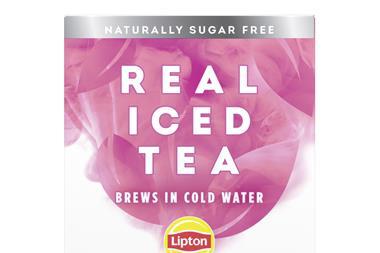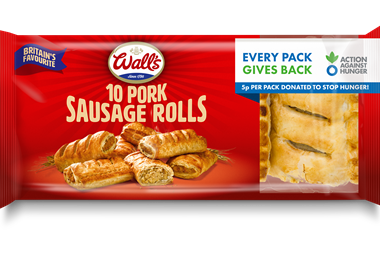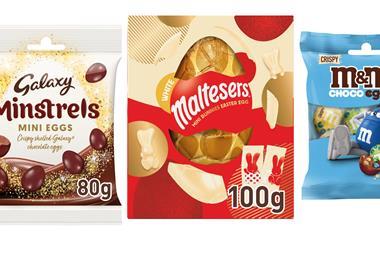Shifts in the market mean it’s important retailers strike the balance between old favourites, reformulations, healthy drinks and new lines.
As the sun makes a welcome return this spring, customers will be welcomed back to their local c-stores time and again as they search for hydrating, refreshing and great-tasting soft drinks. In fact, more and more consumers are visiting convenience stores just to pick up a soft drink, according to HIM Research & Consulting.
Soft drinks have been identified by HIM as the third most popular reason for visiting a c-store, overtaking bread in terms of importance. Some 10% of shoppers stated it was the main reason for them when visiting a store in 2016, compared with 8% in 2015; only milk and tobacco scored higher.
The channel has seen fierce competition over the past year, says Trystan Farnworth, commercial director for convenience and impulse at Britvic. “Convenience maintained a steady performance in soft drinks thanks to the growing consumer demand for on-the-go solutions that fit in with busy schedules, as well as the increasing focus on healthier lifestyles. With the health trend continuing to gain momentum, and convenience under-trading in no- and low-sugar soft drinks, retailers should see this as a major opportunity and the perfect time to take stock and ensure their range is fit for the future.”
For Manny Patel, owner of Manny’s in Long Ditton, Surrey, it’s big brands and value that his shoppers are after. “Our biggest sellers are Coca-Cola, Red Bull, Lucozade and Pepsi,” he says. “When it comes to cola drinks, customers will only buy Coca-Cola or Pepsi, because they are the market-leading brands, so we don’t stock any other brand, but when one of them is available in a pricemarked bottle or can, they outsell the other, showing that price is also still key in the category.”
Stocking big brands with a proven reputation is definitely the way to go, according to Harj Dhasee, owner of Nisa Mickleton in Gloucestershire. “The most popular lines for us are the original variants of Coca-Cola, Pepsi and Red Bull, because they are market-leading big brands, and when it comes to small bottles or cans for now, consumers are looking for brands they recognise.”
Harj acknowledges, though, that the focus on health is shaking things up in the soft drinks chiller. “I think the market is moving towards low- and no-sugar products, obviously as a result of government pressure on manufacturers, who are doing their best to reformulate and come up with new and exciting products in that sub-category. Over the next few years I expect this market to grow, but having said that I don’t think it will outgrow the original full-sugar products such as Coca-Cola, Pepsi and Red Bull.”
Mark Sterratt, head of market, strategy and planning at Lucozade Ribena Suntory, points out that 92% of consumers are looking to reduce their sugar intake, causing the soft drinks category to evolve. “The growth of low- and no-calorie soft drinks is outpacing the growth of the wider soft drinks category and, with water included, now claims a 38% share. We anticipate this trend to continue throughout summer and beyond.”
Health is being heralded as a major growth opportunity for convenience retailers by Britvic, too. It reveals there was huge consumer interest in low- and no-sugar soft drinks in 2016, which saw sales rise to account for 11% and 18% of the entire convenience channel’s soft drinks sales respectively (Nielsen).
Farnworth says: “At Britvic, we recognised the impact of the healthy living trend early on. We’ve taken bold steps to help consumers to make choices that are better for them, removing 19 billion calories per year from our portfolio since 2012. We will continue to keep our commitment to providing consumers with inspiring choices that deliver on taste at the heart of our strategy in the years to come.”
Amy Burgess, trade communications manager at Coca-Cola European Partners, highlights the importance of stocking a wide selection of low- or zero-sugar drinks. “Retailers should constantly review their soft drinks range as manufacturers innovate with new lighter options to meet rising consumer demand for healthier options,” she says.
“Looking ahead there will be a continued focus from CCEP on the innovation of lower- or zero-calorie products to cater for the increasing consumer demand, following on from the successful launch of Coca-Cola Zero Sugar last summer. 2017 is already seeing the latest zero-calorie options hit the market, including new Monster Energy Ultra Citron and Glacéau Smartwater sparkling.”
Manny makes sure he gives NPD in low- or no-sugar products a try as “like in most categories, soft drinks customers react on impulse when the range is changed and we trial a new product”. He adds: “Some work and some don’t, but it is important to give them a chance because you don’t want to miss out. We started stocking Lucozade Zero and it worked.”
Another sub-category in growth as a result of the growing health trend is bottled water. Carol Saunders, head of customer marketing at Highland Spring Group, says: “Bottled water’s lack of calories, sugar, preservatives and additives, together with its convenience and refreshing taste, provides health-conscious consumers alternatives to fizzy drinks. Within the convenience channel, plain bottled water grew in volume by 12.4% in the past 52 weeks (IRI, Convenience 52 w/e 25 February 2017) and is the second biggest volume contributor within soft drinks for the convenience channel with a volume share of 17.1%.”
Ollie Lodge, owner of Rusdene Services in Waterlooville, Hampshire, says that he has noticed customers buying water as a guilt-free drink. Ollie says: “This plays into the health trend, as customers are getting more and more health conscious and the health warnings over sugar content are everywhere at the moment.
“When the weather gets warmer I notice a shift towards bottled water and flavoured water lines, such as Volvic flavoured variants and Drench, whether this is for hydration or low calories. Big brands in water continue to perform strongly in the summer months; the likes of Evian, Nestlé and Highland Spring. I think this comes down to the brand – my customers aren’t as price conscious when it comes to drinks as they are in other areas.”
Flavoured water is a trend that can’t be ignored, says Ed Jones, senior customer marketing manager at Vimto and Feel Good Drinks. He explains: “New Vimto flavoured water, Vim2o, was added to the market because water is the best-performing soft drink, currently worth more than £1bn and growing at 7.6%. One of the drivers for this is flavoured waters – more than 12 million households now buy it and the category is growing at twice the rate as the soft drinks market, so it makes sense for us to tap into this trend and bring the distinct Vimto taste to water.”
Other retailers have witnessed a growth in sales of bottled water. Harj also puts this down to the growing health movement. “Consumers are taking note of how much sugar and how many calories are in the products they consume and they are making more informed decisions when they buy a product. I think customers are either going for the big brand soft drinks for a sugar fix and hydration as a drink to consume now, or they are focusing more on hydration and don’t need a sugar fix and are going for a bottle water, ice tea or fruit water.
“We sell a lot of Lipton Ice Tea, bottled water and fruit-flavoured waters from the likes of Volvic. These products perform better than the diet or zero variants of soft drinks for us at the moment. We have given bottled water and these still drinks three extra shelves in the chiller in preparation for the summer.”
Barrie Seymour, who owns a Londis store in Liversedge, West Yorkshire, says that he has increased his range of bottled water a lot in the past year and now has 1.25 metres dedicated to them. “People are buying a lot more water than they used to and I think this is because they are generally becoming much more interested in their health and fitness. I’ve noticed a lot more people using the leisure facilities that are within walking distance from the store, and I think they pick up water to drink while working out.
“Our most popular water brands are Evian, Glacéau Smartwater and Volvic Touch of Fruit. I don’t know what’s smart about the Smartwater, but people seem to be buying into the branding and they like the sports cap bottles.”
Soft drink trends
According to the Britvic Soft Drinks Review 2017, there are new emerging trends to be aware of.
• 29% now consuming soft drinks immediately on purchase, according to Britvic Soft Drink Review (HIM data)
• UK soft drinks sales remain steady in 2016, reaching £2.1bn with 0.9% growth, according to Britvic Soft Drinks Review
• Low- and no-sugar soft drinks sales in 2016 rose to account for 11% and 18% of the entire convenience channel’s soft drinks sales, according to Britvic Soft Drinks Review (Nielsen data)
• According to HIM, plain water grew by 7.5%, while smoothies and water-plus products grew 13.5% and 3.8% respectively.
• 49% of all c-store shoppers consider healthy options important (HIM).
Merchandising
The soft drinks category serves a number of different customer missions and the category’s versatility means that retailers need to merchandise efficiently to maximise the fixture’s potential.
Carol Saunders at Highland Spring says key water lines should be positioned in the bottom right- or left-hand side of the chiller, depending on your traffic flow, including both still and sparkling. She adds: “Retailers should avoid single facings to help maintain availability and ensure water is always visible and available. Water should also be offered as part of a meal deal, and retailers in larger stores should consider stocking larger bottles of water and multipacks in ambient space.”
Amy Burgess at CCEP has this advice: “Creating eye-catching displays can help increase sales, especially impulse buys. Additionally, cross-merchandising soft drinks with other items such as meal deals, barbecue items and food, and offering combination deals, is a great sales opportunity for retailers, providing consumers with value for money.”
Harj Dhasee uses POS material to communicate his offering to shoppers. “We market the soft drinks all in a wide chiller, with plenty of POS material such as shelf talkers and messaging. We put them in the chiller neighbouring the other fridges – one with sandwiches and snacks and the other with cakes and cookies – that way it plays into the meal-time missions and on-the-go consumption trend.”
Ollie finds that single-serve cans and bottles are most popular, so he gives them more space. “For us, as a forecourt shop, customers want single-serve variants, so these pack sizes are particularly important to us. Because on the go is a growing trend across categories, we merchandise products together where we can to encourage cross-category purchases and increase basket spend. For example, we have soft drinks chillers near to our sandwiches and snacks,” Ollie says.
Chilling them is a must, he adds. “Customers want to grab and go, and will want to instantly consume that product, so there is no point selling drinks that aren’t chilled. All of our soft drinks are chilled and constantly faced up thanks to a spring-loaded chiller that pushes the bottles and cans to the front once one has been removed, which saves us a lot of time and labour.”
Instant consumption is a major mission for soft drinks, according to Farnworth at Britvic. “With 29% now consuming immediately on purchase, the on-the-go nature of shopper lifestyles presented significant sales opportunities for retailers in 2016.
“This increasing consumer appetite for immediate refreshment encouraged savvy retailers to re-evaluate the premium chiller space and adapt their ranges according to the specific needs of their customer base. This approach increased wider profits, as soft drinks shoppers were shown to spend more, visit the store more often and have a bigger basket size, compared with average convenience shoppers.”
It can be tricky for retailers to get range and space right all the time, that’s why some retailers work with leading brands to help increase sales from soft drinks. Ollie works with Red Bull: “They provide us with planograms based on market research and give us in-depth advice on how to best merchandise the category in a RTD area, a meal deal area and impulse chillers. I would recommend other retailers get help merchandising from brand partners because they have a wealth of knowledge.”
Sterratt of Lucozade Ribena Suntory (LRS) advises making use of POS and support materials from suppliers. “LRS provides extensive support through a variety of initiatives including offering 16,000 branded chillers, POS and supporting materials. As well as this, LRS has a dedicated field sales team, so retailers should get in touch with their local sales representative to find out how they can boost soft drink sales.”
He also advocates stocking pricemarked packs when available, as he says pricemarked soft drinks have a faster rate of sale for independent and symbols than their non-PMP equivalents and this rate of sale is increasing, up 5.5% in the past year.
Ed Jones from Vimto says it, too, is seeing increased demand for PMPs, which offer reassurance of value for money. “That’s why our new raspberry, orange and passionfruit flavour Vimto Remix is available only in a £1 PMP within the 500ml format.”
Harj says that at his store he stocks as many PMPs as he can. “We also stock a ‘two for one’ deal on some big brands. This is really popular on Red Bull and customers can pick up two for £2. Price is most important when it comes to 2ltr bottle variants, while big brands are more important when it comes to smaller variants.”
Red Bull category development manager Rich Fisher says: “PMPs provide customer confidence in brands and help to increase basket spend, with 68% of UK shoppers likely to compare prices carefully and 44% of shoppers more likely to buy a product if a PMP is visible.”
This rings true at Barrie’s store, where energy is king in the soft drinks category. “Monster Energy is our top-selling line. In the winter, 14 of the top 20 selling soft drinks are energy drinks and eight of those are cheap Euro Shopper-branded.”
Manny agrees that for many, price is still a key element in soft drinks and so he stocks PMPs where he can, on as many big brands as he can. “This is a winning combination and customers appreciate that they can get the product and brand they like and trust and know tastes good, at a good value price point.”
It’s clear that the category is in a state of flux as suppliers focus on reformulations and new products, so Ollie Lodge is advising retailers to keep an open mind and give customers a wide range.
He explains: “It is clear that the category is going through a period of slight turbulence as it is yet to be seen how consumers’ habits will be affected by a sugar levy and pressures from health professionals. While they [the low and no sugar variants] are gaining small steps, it is probably a market that is going to be a slow burner and one that may take a few years to really take off, and retailers need to be ready to capitalise.
“Whether it is hydration, taste, zero sugar or something a bit different, it is important that consumers continue to be given a wide choice.”























No comments yet